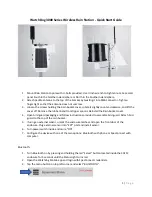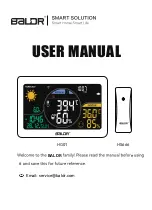
Appendix: Weather Data
Page 54
Vantage Pro Manual
EvapoTranspiration (ET)
EvapoTranspiration (ET) is a measurement of the amount of water vapor
returned to the air in a given area. It combines the amount of water vapor
returned through evaporation (from wet vegetation surfaces and the stoma of
leaves) with the amount of water vapor returned through transpiration (exhal-
ing of moisture through plant skin) to arrive at a total. Effectively, ETo is the
opposite of rainfall, and it is expressed in the same units of measure (Inches,
millimeters).
The Vantage Pro uses air temperature, relative humidity, wind run
1
, and solar
radiation data to estimate ET. (ET is calculated once an hour on the hour.)
Please note that calculating ET requires the optional solar radiation sensor. (See
“Optional Sensors” on page 9.)
Leaf Wetness
Leaf wetness (see “Optional Sensors” on page 9) provides an indication of
whether the surface of foliage in the area is wet or dry by indicating how wet
the surface of the sensor is. The leaf wetness reading ranges from 0 (dry) to 15.
Note:
Leaf Wetness is only available with the wireless Vantage Pro and the optional Leaf Wetness station.
Soil Moisture
Soil Moisture, as the name suggests, is a measure of the moisture content of the
soil. Soil moisture is measured on a scale of 0 to 200 centibars, and can help
choose times to water crops. The soil moisture sensor measures the vacuum
created in the soil by the lack of moisture. A high soil moisture reading indi-
cates dryer soil; a lower soil moisture reading means wetter soil.
Note:
Soil Moisture is only available with the wireless Vantage Pro with the optional Soil Moisture station.
Time
The Vantage Pro has a clock and a calendar for tracking time and date. The cal-
endar automatically adjusts during leap years, providing you have entered the
correct year in the Setup Mode.
1. Wind run is a measurement of the “amount” of wind passing a given point during a specific
amount of time. It’s expressed as either “miles of wind” or “kilometers of wind” and is calculated
by summing wind speed and multiplying by the time of the measurement period. For example, if
the wind blew at an absolutely steady 10 MPH for 12 hours, you would have 120 miles of wind
run (speed x time = 10 MPH x 12 Hours = 120 miles.
Summary of Contents for and Vantage Pro
Page 1: ......
Page 2: ......
Page 40: ...Chapter 3 Page 40 Vantage Pro Console Manual...
Page 46: ...Troubleshooting Page 46 Vantage Pro Manual...
Page 55: ...Page 55 Vantage Pro Manual...
Page 56: ...Page 56 Vantage Pro Manual...
Page 57: ...Page 57 Vantage Pro Manual...
Page 58: ...Page 58 Vantage Pro Manual...







































